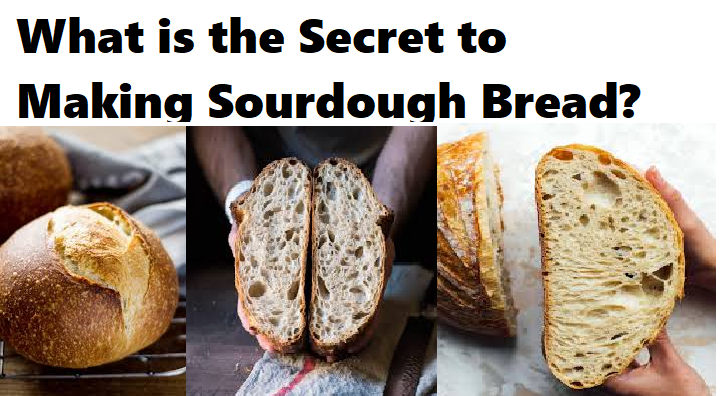Sourdough bread is a delicious, tangy bread with a unique texture and a rustic charm that sets it apart from regular loaves. The secret to making sourdough lies in its fermentation process and the simplicity of its ingredients. Let’s explore the process and the key aspects of how to make sourdough bread.
What is the Process of Making Sourdough?
The process of making sourdough bread involves creating a sourdough starter, which is a mixture of flour and water left to ferment naturally. This fermentation helps develop wild yeast and lactic acid bacteria, which give sourdough its distinctive flavor. Here's an overview of the steps:- Create the Starter: Mix equal parts flour and water, and let it sit at room temperature. You will need to "feed" the starter regularly with fresh flour and water over several days until it becomes bubbly and active.
- Mix the Dough: Combine some of your active starter with more flour and water. Allow the dough to rest, then add salt.
- Knead and Rest: Knead the dough lightly and let it rest and rise over a period of hours. This allows the fermentation process to work, creating the bread’s structure and flavor.
- Shape and Final Rise: Shape the dough into a loaf and let it rise one last time before baking.
- Bake: Finally, bake your loaf in a hot oven, often using a Dutch oven to create steam and help develop a crispy crust.
How is Real Sourdough Bread Made?
Real sourdough is made without commercial yeast. It relies entirely on the wild yeast that naturally develops in the sourdough starter. The process may take longer compared to bread made with commercial yeast, but the flavor and texture are worth the wait. The slow fermentation gives sourdough its characteristic sour taste and chewy texture.Is Sourdough Healthier for You than Regular Bread?
Yes, sourdough is often considered healthier than regular bread. The fermentation process helps break down gluten, making it easier to digest. Additionally, sourdough has a lower glycemic index, meaning it won’t spike your blood sugar as much as other breads. The natural fermentation also promotes gut health by producing beneficial bacteria.What is the Best Flour for Sourdough Bread?
The best flour for making sourdough is usually unbleached all-purpose or bread flour, which has a higher protein content. This helps develop a strong gluten structure for a good rise. Many bakers also prefer to use whole wheat or rye flour for their starters, as these flours tend to ferment more actively due to their higher mineral content.How Does Sourdough Work Without Yeast?
Sourdough works without commercial yeast because of the wild yeast naturally present in the air and on the flour. When you mix flour and water, these yeasts begin to ferment, producing gases that cause the dough to rise. The lactic acid bacteria present in the starter also contribute to the leavening process, giving sourdough its unique flavor.How Long Will Sourdough Bread Stay Fresh?
Sourdough bread stays fresh longer than regular bread, thanks to the acidity from the lactic acid. Typically, it can last up to 4-5 days at room temperature when stored properly in a bread bag or a covered container. For longer storage, you can freeze sourdough, and it will last for several months.What is Needed to Start Sourdough?
To start sourdough, you need only two ingredients: flour and water. You’ll also need patience, as the starter requires time to develop its natural yeast and bacteria. Regular "feedings" of flour and water help maintain the starter's health.Is Sourdough Just Flour and Water?
Yes, at its core, sourdough is just flour and water. However, salt is typically added to the dough for flavor. The magic comes from the fermentation process, which transforms these simple ingredients into a flavorful, complex loaf of bread.What are the Benefits of Sourdough Bread?
- Better Digestion: The natural fermentation process breaks down gluten, making it easier to digest.
- Low Glycemic Index: Sourdough causes a slower rise in blood sugar compared to regular bread.
- Rich in Nutrients: Sourdough contains more vitamins, minerals, and antioxidants.
- Longer Freshness: The natural acids act as preservatives, extending the shelf life of sourdough bread.
What to Eat with Sourdough Bread?
Sourdough is versatile and pairs well with many foods. You can enjoy it with butter, cheese, soups, or even make sandwiches. It’s also excellent for toast, bruschetta, or French toast.Can I Eat 2-Week-Old Sourdough Bread?
If stored properly, sourdough bread can last a while, but 2-week-old bread may become quite hard. While it’s unlikely to spoil quickly, it’s best to check for mold and dryness. If it's hard but mold-free, you can still use it to make croutons or breadcrumbs.Is It Okay to Eat Sourdough Bread Every Day?
Yes, eating sourdough bread every day can be part of a healthy diet, especially if you're consuming it in moderation. Its lower gluten content and fermentation benefits make it a good alternative to regular bread.Can I Toast Sourdough Bread?
Absolutely! Toasting sourdough brings out its tangy flavor and gives it a crispy texture, making it a perfect base for toppings like avocado, butter, or jams.What Not to Do with Sourdough?
- Don’t Rush the Fermentation: Sourdough requires time for the flavors to develop.
- Don’t Use Chlorinated Water: It can inhibit the growth of wild yeast in your starter.
- Don’t Ignore Your Starter: Feed your starter regularly to keep it healthy.
Read more:
1= https://dapachecker.co.uk/what-is-the-secret-to-making-sourdough-bread/
2= https://dapachecker.co.uk/how-to-make-scrambled-eggs-step-by-step/
3= https://dapachecker.co.uk/how-to-make-pizza-dough-key-ingredients-and-steps-explained/
